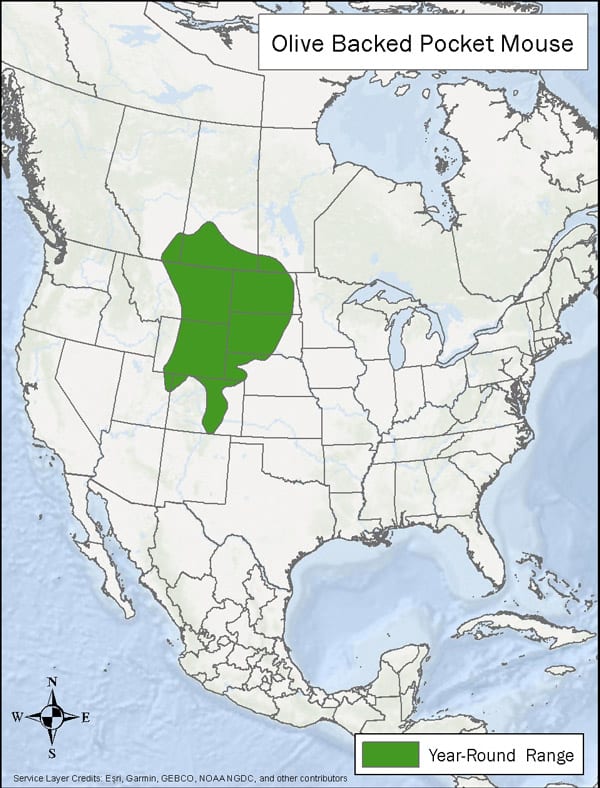LandPKS Learning
Habitat Hub

Olive-backed Pocket Mouse
External cheek pouches of olive-backed pocket mice, like other pocket mice are fur-lined and are used to collect and transport large quantities of seeds.
Perognathus fasciatus
Identification
The olive-backed pocket mouse is a small rodent about the size of a house mouse, 6 in/15 cm (including tail), with a relatively long tail and small ears. Fur is generally olive-gray fur on their back, white belly and a yellowish-buff line down their sides, and small patches of light-yellow fur behind each ear. Pocket mice collect seeds in cheek pouches to store underground in their burrows or on the soil surface. They may also consume green vegetation and insects in early summer. Olive-backed pocket mice are nocturnal and move with a hopping style. Widely distributed in arid short/mixed grass prairies from southern Canada, south to the Dakotas to the eastern plains of Colorado.
Observation Tips
These mice spend much of the day in the burrow and become active above ground only at night. From mid-October to April, olive-backed pocket mice are thought to alternate periods of torpor (lowering their body temperature to conserve energy) and activity, feeding on food stored in their burrows. They are rarely observed incidentally. Pocket mice generally have low capture probability in small mammal surveys leading to a lack in understanding of their biology, abundance and population trends.
Interesting Fact
External cheek pouches of olive-backed pocket mice, like other pocket mice are fur-lined and are used to collect and transport large quantities of seeds. Like other pocket mouse species, they are well adapted for water conservation and require little free water to drink, obtaining water from their food.
Ideal Habitat
Olive-backed pocket mice are found in the northern Great Plains and Wyoming Basin in arid and semi-arid sandhill grasslands and shrublands, as well as floodplains with scattered cottonwoods (in southwestern North Dakota). Sites with low densities of shrubs (<30%), provide cover from raptors and predators. Sparse, low stature vegetation (<4 ft/1.2 m) with 10-30% bare ground allows for easy movement for foraging and escaping danger. Commonly associated with sites with sedge, blue gramma and wheat grass. Loose sand or sandy loam soils are preferred by olive-backed pocket mice as they are active burrowers, sleeping, sheltering and birthing in burrows between 1 ft-6 ft/30 cm-2 m below ground. Found in greater abundance on sandier soils with high sedge cover. In addition, olive-backed pocket mice are known to feed on early successional grass and forb species that colonize disturbed sites including knotweed, Russian thistle, pigweed and foxtail grass, and are often found along roadsides and edge of field in row crops.

Range Map provided by The International Union for Conservation of Nature
Management Activities that Benefit Species – Best Management Practices (BMPs)
As olive-backed pocket mice prefer open habitats with sparse, short vegetation and moderate amounts of bare ground, grazing is beneficial especially in ways that increase diversity of grasses, forbs and shrubs producing high numbers of seeds. Trampling and grazing of sandy areas that leads to small-scale openings, localized blowouts, and reactivation of sand dune complexes is favorable for olive backed pocket mice. Grazing management should focus on light or moderate stocking rates sensitive to erosion potential in sandy areas and shifts patches of heavier use over the landscape and between years followed by periodic rest. Areas of deferred spring grazing that shift between years is beneficial as it allows for increased seed production and promotes plant vigor to ensure a stable seed source. When utilizing season-long grazing, vary the placement of water, mineral supplements and herding over space and time to shift the localized heavy use across the landscape.
Management Activities to Avoid
Management actions that degrade sandhill and sand dune habitats, including conversion for agriculture or development and heavy, uncontrolled off-road vehicle use should be avoided as they are fragile ecosystems that are sensitive to disturbance. Avoid extensive use of herbicides or pesticides near known olive-backed pocket mouse habitats as direct poisoning or consumption of contaminated seeds is likely. Similarly, avoid widespread poisoning programs that involve distributing poison grain.
Other Species that Benefit from Similar Habitat Management
Other species that inhabit high quality native arid short/mixed grass prairies including the greater sage-grouse, Ord’s kangaroo rat, swift fox, pronghorn, and greater short-horned lizard benefit from similar habitat management.
Download
Download the Olive-backed Pocket Mouse factsheet
Descarga la ficha de raton con abazones de espalda oliva
Other Resources
NatureServe. 2019. NatureServe Explorer: An online encyclopedia of life [web application]. Version 7.1. NatureServe, Arlington, Virginia. Olive-backed pocket mouse
International Union for Conservation of Nature (IUCN). 2019. The IUCN Red List of Threatened Species. Version 2019-3. Olive-backed pocket mouse
Wyoming Game & Fish Department. State Wildlife Action Plan: Species Account, Olive-backed pocket mouse.
Mobile App | Data Portal | Knowledge Hub | Habitat Hub | Learning Collections | Blog | About | Contact | Support



